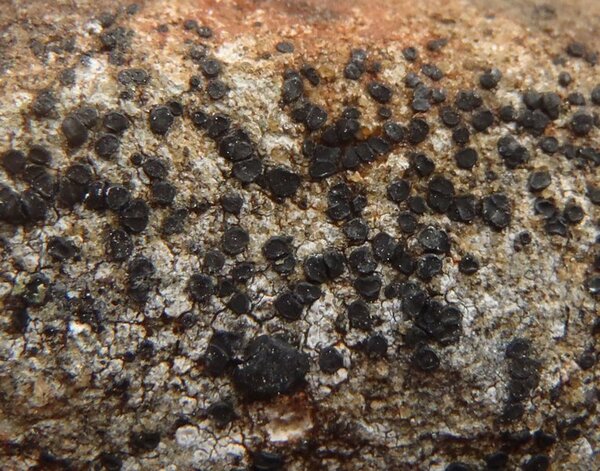Lecidea diducens Nyl.
Flora, 48: 148, 1865.
Synonyms: Lecidea auriculata var. diducens (Nyl.) Th. Fr.; Lecidea auriculata var. subfoederata Vain.; Lecidea sarcogyniza Nyl.
Distribution: N - TAA (Hertel 2001, Hertel & Schuhwerk 2010), Lomb (S-F86838), Piem (Isocrono & al. 2004), VA (Piervittori & Isocrono 1999), Lig.
Description: Thallus crustose, endosubstratic or very thinly episubstratic and grey-white, without a distinct prothallus. Medulla I+ intensively violet-blue (but usually very thin and reaction difficult to observe). Apothecia lecideine, black, sessile and constricted at base, round or irregular in outline, sometimes confluent, 0.4-0.8(-1.5) mm across, with a flat, mostly epruinose disc and a prominent, rather thick, persistent proper margin. Proper exciple of intricate-radiating hyphae, 100-130 µm wide laterally, extending below the hypothecium, dark brown to violet-brown in the 15-22 µm thick outer part, paler and inspersed with small crystals within, C+ red; epithecium olive-black, blue-green or blue-black, c. 10 µm high; hymenium colourlessto pale green, (30-)35-50(-55) µm high; paraphyses coherent, mostly simple, 2-2.5 µm thick at mid-level, the apical cells 3.5-4 µm wide; hypothecium pale brown to colourless, often rgeenish in upper part, with a thick medulla. Asci 8-spored, narrowly clavate, thick-walled, with a K/I+ pale blue tholus and a strongly amyloid, thin apical cushion, surrounded by a I+ blue outer layer, Lecidea-type. Ascospores 1-celled, hyaline, narrowly ellipsoid with obtuse ends, (5-)7-11(-12) x (1.7-)2-3(-3.4) µm, 2.5-4.1 times as long as wide. Pycnidia black, weakly graphidioid. Conidia 11-16 x c. 1 µm. Photobiont chlorococcoid. Spot tests: thallus and medulla K-, C-, KC-, P-. Chemistry: 2'-0-methylanziaic acid in apothecia, confluentic acid in thallus.Note: a circum- and bipolar, arctic-alpine silicicolous lichen (Hertel 2006), ecologically similar to, and closely related with L. auriculata.
Growth form: Crustose
Substrata: rocks
Photobiont: green algae other than Trentepohlia
Reproductive strategy: mainly sexual
Commonnes-rarity: (info)
Alpine belt: rather rare
Subalpine belt: very rare
Oromediterranean belt: absent
Montane belt: absent
Submediterranean belt: absent
Padanian area: absent
Humid submediterranean belt: absent
Humid mediterranean belt: absent
Dry mediterranean belt: absent

Predictive model
Herbarium samples
Growth form: Crustose
Substrata: rocks
Photobiont: green algae other than Trentepohlia
Reproductive strategy: mainly sexual
Commonnes-rarity: (info)
Alpine belt: rather rare
Subalpine belt: very rare
Oromediterranean belt: absent
Montane belt: absent
Submediterranean belt: absent
Padanian area: absent
Humid submediterranean belt: absent
Humid mediterranean belt: absent
Dry mediterranean belt: absent

Predictive model
| Herbarium samples |
 INDEX FUNGORUM
INDEX FUNGORUM
 GBIF
GBIF
 DOLICHENS
DOLICHENS




